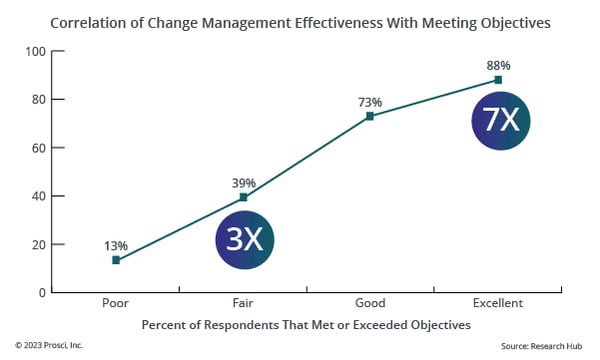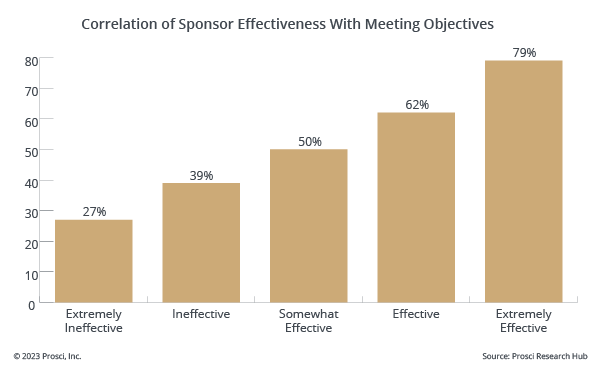You have no items in your shopping cart.
4 Ways to Build Better Change Outcomes With Research and Data

3 Mins
Updated: August 5, 2024
Published: October 12, 2022

One of my secret weapons to improve organizational outcomes as a Change Advisor is data. As part of our role as change practitioners, we regularly assess, measure and track progress through various data points. But for me, the need for data starts earlier than that as I build commitment and support for change management on projects, help others understand change management, and much more.
The Value of Data in Change Management
Prosci’s biennial Best Practices in Change Management benchmarking research shares what others in the discipline are doing, the challenges they’re facing, and the successes they’re achieving. The rigor behind the data also helps make change management less “soft,” enables change practitioners to frame the work we do more concretely, and supports adoption and usage in business terms.
As an Engagement Leader and member of the Prosci Advisory Services team helping clients and organizations develop change capabilities, I leverage the Best Practices in Change Management data and insights in four distinct ways:
1. Building commitment and support
Pulling information directly from the report to influence key stakeholders, either within the project team or with senior leaders, is a common way I use the data. I often share the correlation between highly effective change management and projects coming in on-time, on-budget, and meeting or exceeding objectives. This graph is especially persuasive when you're trying to gain support for a dedicated resource to serve in the change manager role. Even more importantly, this data can be a driving force for building support for change management as an enterprise capability. When talking to senior leaders, this addresses what they most care about in the language that resonates with them.

2. Building understanding and capability in others
Driving successful change in individuals and organizations requires new thinking, new models and new tools. It takes education to build both understanding and capability. As noted in the Best Practices in Change Management – 12th Edition, misunderstanding about change management—what it is and isn’t—is an ongoing challenge for the discipline. To address this issue, the first thing I try to do on every project is ensure a level set with certain groups that will support change. And I turn to the research to make sure we’re all on the same page. For example, with project managers, I often talk through the integration of project and change management, as well as the steps and advice for alignment and roles.
Executive sponsors and the sponsorship coalition often need to build their own change understanding and capability as well. The research includes great insights on what it takes to be an effective sponsor of change, including traits of effective sponsors, the most critical activities, and common mistakes to avoid. Among research respondents, those with a very effective sponsor were more than twice as likely to meet or exceed project objectives than those who had very ineffective sponsors. The data shows that is clearly a group to support in building their change capability.

3. Building client solutions
When working on transformation initiatives, I almost always share the Best Practices in Change Management research to guide clients and help them build out solutions.
If you’ve been doing change management even a little while, you know it is common for companies to overestimate how easy it is for individuals to embrace change and underestimate the amount of time, energy and support it takes to get the return on investment from change initiatives. The report’s findings on resources and team structure are particularly helpful in these areas, offering insights to teams struggling to gauge how much support they need and determine what the change reporting support structure should look like.
Organizations can also underestimate the level of skill required to effectively manage change. The benchmarking research includes very specific best practices and criteria for identifying who within a company might be good candidates to develop into change practitioners. I often share this data with key stakeholders to help shape their foundation on projects.
I also frequently see change practitioners who have zero or very limited access to the sponsor. When that’s the case, I refer to them to the research on sponsor access and change management effectiveness.
_blog%20image_Title-01.png?width=600&name=Figure-10.7%20(1)_blog%20image_Title-01.png)
4. Building inspiration and personal capability
I often find inspiration and ways to build my own change capability within the pages of the Best Practices in Change Management reports. One thing that revved up my creative juices in the latest report is the chapter on sponsorship. This chapter can be used in so many ways. The information on sponsor challenges offers particularly helpful data and insights about possible adaptations for remediation when your sponsor is at the wrong level (too high or too low) to be effective or lacks time and resources, or even when sponsors delegate their role and responsibilities to someone else.
To find your inspiration and identify areas for your capability building, I recommend starting with a deep dive into the report—really take time to absorb the information, make notes, and bookmark specific numbers and graphs you might want to keep at your fingertips. I promise you will be inspired to think critically about how you are engaging your sponsors and supporting them in their role with very specific tactics.
As for my own growth, I’m most inspired by Part 4: Adapting and Aligning Change Management. This section covers everything from culture considerations to portfolio management. One particularly useful chapter offers actionable insights for navigating specific project types that make change management complex, such as change that spans wide geographic areas or change with little or no WIIFM. As I delve into this content, I am outlining where I want to spend some experimenting and developing my own skills.
Best Practices in Change Management
Prosci’s research comprises the largest body of knowledge about change management in the industry. Building upon that solid foundation, Best Practices in Change Management – 12th Edition adds modern insights and data to your change management toolkit, so you can help people in your organization understand the importance of change management, the roles they must play, and how to build effective change capabilities. The research also equips and enables you as a practitioner, enhancing your growing capabilities as a leader of change.


